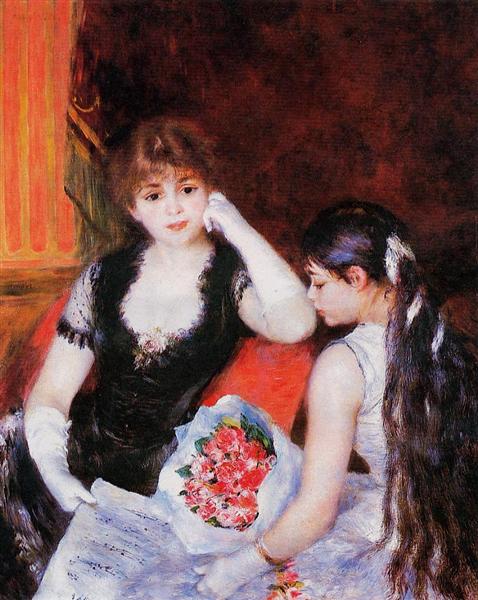Description
La peinture "dans le concert (Palco de la Opera)" de Pierre-Auguste Renoir, créé en 1880, est une œuvre qui résume l'élégance et la vie sociale dynamique de la fin du XIXe siècle, tout en démontrant la maîtrise de l'artiste dans l'utilisation de la couleur et lumière. Cette œuvre se distingue non seulement de sa représentation d'un moment éphémère dans l'expérience de l'art en direct, mais révèle également les nuances des émotions humaines et de l'interaction sociale dans un environnement luxueux.
Dans ce tableau, Renoir transporte le spectateur dans une boîte de l'opéra, où deux femmes deviennent l'objectif central. Les deux figures sont élégamment habillées, ce qui met en évidence le sens de la mode de l'époque et de son statut social. La femme de gauche, avec une robe claire et des ornements dans sa coiffure, montre son visage au spectateur, l'invitant à participer à son monde. Son expression suggère un intérêt et une curiosité qui semble aller au-delà du spectacle qu'il assiste. La femme à droite, avec une robe de couleur plus foncée, observe la scène avec une expression plus introspective, presque captivée par la musique. Cette dualité entre les deux figures invite la réflexion sur les différentes manières dont les gens peuvent vivre de l'art.
L'environnement de la boîte est orné de couleurs et de textures riches qui accentuent l'atmosphère de luxe. Renoir utilise des vins et des tons d'or pour les rideaux, évoquant l'opulence de la pièce. La lumière joue un rôle crucial dans la composition; L'utilisation de réflexes brillants et d'ombres douces suggère une atmosphère presque éthérée, où la lumière semble danser parmi les objets, mettant en évidence les bijoux des dames et les détails subtils de la décoration.
La composition est soigneusement équilibrée, avec des lignes diagonales qui guident le regard du spectateur vers les visages des femmes et de leur environnement. Renoir, dans son style caractéristique, fait un usage magistral du coup de pinceau lâche et dynamique, ajoutant un sens du mouvement et de la vie à la scène. Cette approche a intimement examiné la vivacité de l'expérience libre de la représentation académique, marquant une transition vers ce qui serait l'impressionnisme.
Le contexte historique de ce tableau est tout aussi pertinent. La montée de la bourgeoisie en Europe post-révolutionnaire a permis d'accéder à des événements tels que l'opéra, qui étaient auparavant les nouvelles des classes aristocratiques. Renoir est immergé dans ce scénario, capturant non seulement l'acte d'assister à un spectacle, mais aussi la culture sociale qui l'entoure. C'est le reflet de son temps, où le divertissement et l'expression artistique commencent à entrelacer la vie quotidienne.
Comme dans d'autres œuvres de la même époque, comme «Dance in the Galette Mill», Renoir continue d'explorer l'interaction sociale dans un environnement dynamique. Cependant, dans "In The Concert", l'approche se concentre davantage sur l'intimité et l'émotion que l'acte d'écouter de la musique génère, au lieu de l'activité la plus tumultueuse d'une célébration.
Renoir, à travers son talent, présente non seulement une scène dans une boîte d'opéra, mais est capable d'évoquer un sentiment de communauté, d'émotion partagée dans l'art. "Dans le concert" est donc un témoignage de la transcendance du moment artistique; Un héritage visuel qui invite chaque spectateur à faire partie d'une expérience collective, même dans la contemplation solitaire de l'œuvre.
KUADROS ©, une peinture célèbre sur votre mur.
Peintures à l'huile fabriquées à la main, avec la qualité des artistes professionnels et le sceau distinctif de KUADROS ©.
Service de reproduction des images avec garantie de satisfaction. Si vous n'êtes pas complètement satisfait de la réplique de votre peinture, nous remboursons votre argent à 100%.

